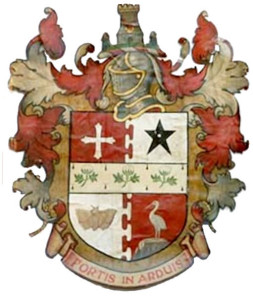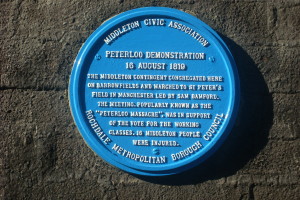Our town of Middleton is within the Metropolitan Borough of Rochdale, in Greater Manchester, England. It stands on the River Irk, 5 miles (8.0 km) south-southwest of Rochdale, and 4.4 miles (7.1 km) north-northeast of Manchester city centre. At the time of the United Kingdom Census 2001, Middleton had a population of 45,580. Middleton lies on the northern edge of Manchester, with Blackley to the south and Moston to the south east.
Historically a part of Lancashire, Middleton took its name from being situated in the centre of several circumjacent settlements. Its early history is marked by its status as an ecclesiastical parish of the hundred of Salford, ruled by aristocratic families. The Church of St Leonard – a Grade I listed building – laid at the centre of this community for centuries. The “Flodden Window”, in the church’s sanctuary, is thought to be the oldest war memorial in the United Kingdom, memorialising the names of the archers of Middleton who fought at the Battle of Flodden Field (1513). In 1770, Middleton was a village of 20 houses; during the 18th and 19th centuries it grew into a thriving and populous seat of textile manufacture, so much so that Middleton was granted borough status in 1886.
Middleton today is a predominantly residential area of contrasting affluence; Langley in the north of the town was one of Manchester City
Council’s overspill public housing estates, whilst Alkrington in the south is a relatively affluent suburban area.
History
In 616 Æthelfrith of Bernicia, an Anglo-Saxon King, crossed the Pennines with an army and passed through Manchester to defeat the Brythons in the Battle of Chester. A wave of Anglian colonists followed this military conquest and their settlements are identified by the “ton” Old English suffix to local place names. Royton, Crompton, Moston, Clayton, Ashton and Middleton are a number of settlements northeast of Manchester suggested to have been founded as part of this colonisation. It is therefore thought that Middleton as a settlement dates from the 7th century.
Although unmentioned in the Domesday Book of 1086, Middleton is said to be “of great antiquity”; a community at Middleton is thought to have evolved outwards from a church that existed considerably earlier than the Norman conquest of England.
The name Middleton first appears in 1194, and derives from the Old English middel-tūn, meaning middle farm or settlement, probably a reference to its central position between Rochdale and Manchester.
The development of Middleton as a centre of commerce occurred during the 17th and 18th centuries. Lord Suffield obtained a Royal Charter from King George III in 1791 to hold a weekly market and three annual fairs in Middleton. Suffield built a market house, warehouses and shambles in the town at his own expense.
Industrial scale textile manufacture was introduced to Middleton as a result of the Industrial Revolution. Middleton became a centre for silk production in the 18th century, which developed into a cotton spinning industry by the mid-19th century and which continued through to the mid-20th century. This transition gave rise to Middleton as a mill town.
Governance
Lying within the historic county boundaries of Lancashire from the early 12th century, Middleton was once an ecclesiastical parish of the hundred of Salford, and in Oldham poor law union.
In 1861 commissioners were established for the improvement of Middleton and Tonge townships or civil parishes. In 1878, the township of Alkrington and parts of the townships of Hopwood and Thornham were added to the area of the commissioners. It was in 1886 this territory was incorporated as a borough, giving it Borough status in the United Kingdom. Following the Local Government Act 1894 parts of Great Heaton and Little Heaton townships were added to the newly created Municipal Borough of Middleton, a local government district in the administrative county of Lancashire. In 1933 there were exchanges of territory between the borough of Middleton, the City of Manchester and Chadderton Urban District. In the same year, parts of Unsworth were amalgamated with Middleton, whilst part of it was moved to Royton Urban District. It was proposed in the Redcliffe-Maud Report that Middleton become part of a new Metropolitan Borough of Oldham, however, following the Local Government Act 1972, the Municipal Borough of Middleton was abolished and its territory became part of the Metropolitan Borough of Rochdale within the metropolitan county of Greater Manchester.
The Middleton parliamentary constituency was created by the Redistribution of Seats Act 1885. It was abolished in 1918 when Middleton became part of the Middleton and Prestwich constituency.




